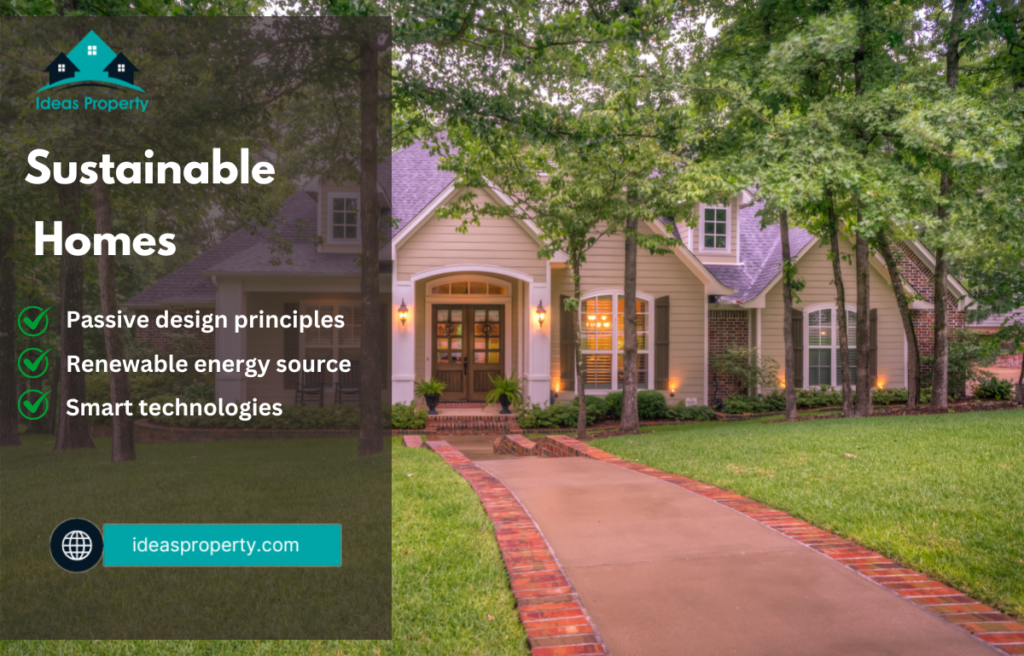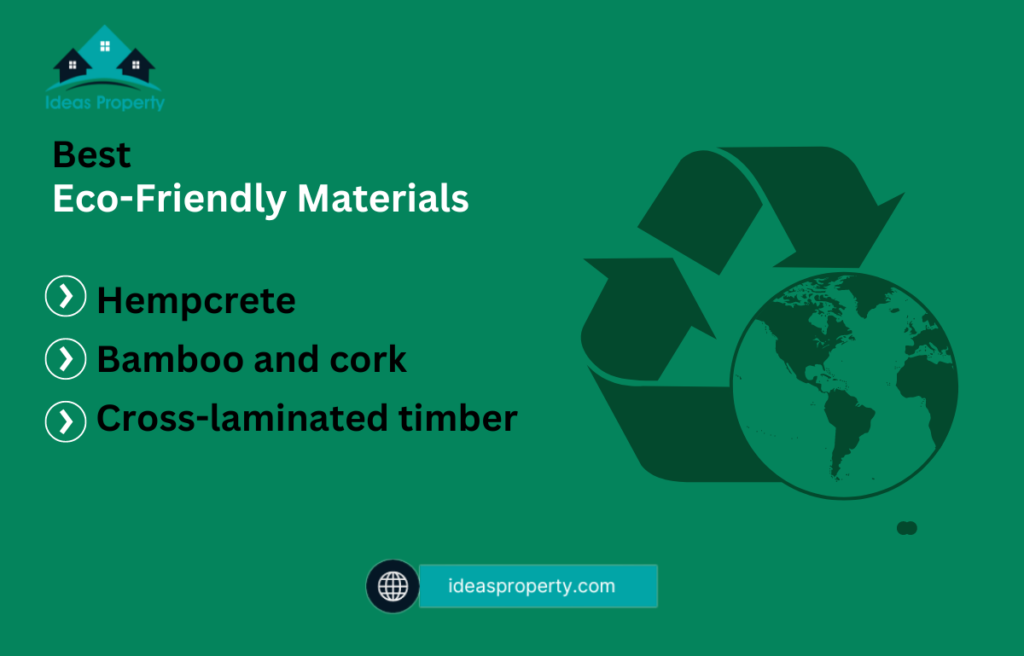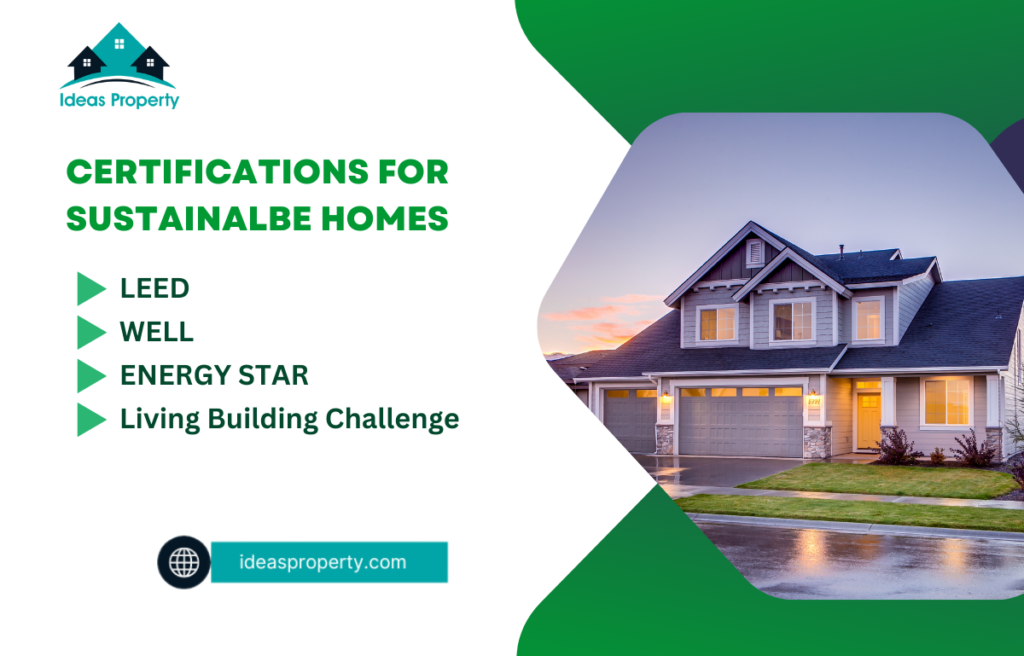As environmental concerns become more pressing, the demand for sustainable homes continues to rise. These homes are designed with the planet in mind, aiming to reduce carbon footprints, conserve resources, and create healthier living environments. A sustainable home is more than just energy-efficient; it incorporates eco-friendly materials, advanced technologies, and thoughtful design to minimize its impact on the environment. From maximizing energy efficiency to integrating smart technologies, sustainable homes represent the future of residential living, where comfort and environmental responsibility go hand in hand.
What Defines Sustainable Homes in 2024?
A sustainable home in 2024 is characterized by its ability to minimize environmental impact while maximizing energy efficiency, resource conservation, and occupant well-being. These homes integrate passive design principles such as strategic orientation, high-performance insulation, and natural ventilation to reduce reliance on mechanical systems for heating and cooling. Additionally, sustainable homes incorporate renewable energy sources like solar panels and geothermal systems to generate clean energy on-site, aiming for net-zero or even plus-energy status, where the home produces more energy than it consumes.
The use of smart technologies also plays a crucial role in defining a sustainable home. These technologies optimize energy use by automatically adjusting heating, cooling, and lighting based on occupancy and time of day. Smart home systems also allow residents to monitor and manage their energy consumption in real-time, further enhancing the home’s efficiency and sustainability.

How Can You Retrofit an Existing Home to Make It More Sustainable?
Retrofitting existing homes to sustainable homes involves several key upgrades that enhance energy efficiency, resource conservation, and overall environmental impact. Improving insulation is one of the most effective ways to increase a home’s energy efficiency. By upgrading to eco-friendly insulation materials like cellulose, sheep’s wool, or recycled denim, homeowners can reduce heating and cooling losses, leading to lower energy consumption and costs.
Installing energy-efficient windows and doors is another important step. High-performance windows with double or triple glazing reduce thermal transfer, keeping the home warmer in the winter and cooler in the summer. These windows, often combined with energy-efficient frames and seals, help to significantly lower the home’s energy needs.
Finally, integrating renewable energy systems like solar panels or geothermal heating can further reduce a home’s carbon footprint. These systems can be installed on most existing homes, providing clean, renewable energy that can power the home’s electrical and heating needs. Coupled with smart home technologies to optimize energy use, these upgrades make retrofitting an existing home a feasible and impactful way to embrace sustainability.
How Do Smart Home Technologies Contribute to Sustainability?
Smart home technologies are pivotal in enhancing the sustainability of homes by optimizing energy use and reducing waste. These technologies, such as smart thermostats, allow homeowners to control heating and cooling systems more efficiently by automatically adjusting the temperature based on occupancy patterns and time of day. This reduces energy consumption significantly, as heating and cooling typically account for a large portion of a home’s energy use.
In addition to thermostats, smart lighting systems contribute to energy savings by using sensors to turn lights on or off based on movement or the presence of natural light. These systems not only reduce electricity usage but also extend the lifespan of lighting fixtures, further minimizing environmental impact. Moreover, smart home technologies often include energy monitoring tools that provide real-time data on energy usage, empowering homeowners to make informed decisions that enhance their home’s overall energy efficiency.
Furthermore, smart home energy management systems can integrate with renewable energy sources like solar panels, optimizing when and how energy is used or stored. This ensures that renewable energy is utilized to its fullest potential, reducing reliance on the grid and lowering carbon emissions. By automating and optimizing various home systems, smart technologies play a crucial role in creating homes that are not only comfortable but also environmentally responsible.
How Does Sustainable Home Design Improve Overall Quality of Life?
Sustainable homes design significantly improves the overall quality of life by creating healthier, more comfortable, and more cost-effective living environments. One of the key benefits is enhanced indoor air quality (IAQ), which reduces the risk of health problems associated with poor air quality, such as allergies and respiratory issues. By using low-VOC materials and incorporating advanced ventilation systems, sustainable homes ensure that occupants breathe cleaner, healthier air.
Furthermore, sustainable homes are designed to optimize natural light and thermal comfort, reducing the need for artificial lighting and excessive heating or cooling. This not only lowers energy bills but also creates a more pleasant living environment that is closely connected to nature. Homes that use passive design principles, such as proper orientation, insulation, and shading, maintain comfortable indoor temperatures year-round with minimal energy use, contributing to both sustainability and occupant well-being.
Finally, sustainable home design often includes features like quiet, energy-efficient appliances and the use of sound-insulating materials, which contribute to a peaceful and serene living environment. These elements, combined with lower utility costs and reduced environmental impact, make sustainable homes a smart choice for those seeking to enhance their quality of life while also caring for the planet.
What Are the Best Eco-Friendly Materials for Building Sustainable Homes?
The best eco-friendly materials for building sustainable homes in 2024 include a mix of natural, recycled, and innovative materials designed to minimize environmental impact while providing durability and energy efficiency. Cross-laminated timber (CLT) is increasingly popular due to its renewable nature and the ability to sequester carbon, making it a sustainable alternative to steel and concrete.
Other notable materials include hempcrete, a lightweight and breathable material made from hemp fibers, and recycled materials like reclaimed wood and recycled steel, which reduce the need for new resource extraction. Bamboo and cork are also favored for their rapid renewability and versatility in flooring and other finishes.
In addition, biobricks and self-healing concrete are emerging as innovative solutions that not only reduce energy consumption during production but also extend the lifespan of buildings, further contributing to the sustainability of homes.

What Is the Role of Water Conservation in Sustainable Home Design?
Water conservation is a critical element of sustainable home design, directly impacting resource efficiency and the environmental footprint of a household. Low-flow fixtures such as faucets, showerheads, and toilets are essential components of water-efficient homes. These fixtures reduce water usage without compromising performance, significantly lowering the amount of water consumed on a daily basis.
Rainwater harvesting systems are another effective strategy for water conservation. These systems collect and store rainwater for non-potable uses like irrigation, toilet flushing, and laundry. This not only reduces demand on municipal water supplies but also helps in mitigating stormwater runoff, which can lead to erosion and water pollution. By utilizing rainwater for household needs, sustainable homes contribute to the conservation of fresh water, a vital but limited resource.
Additionally, greywater recycling systems play a significant role in sustainable home design by treating and reusing wastewater from baths, sinks, and laundry for irrigation or toilet flushing. Implementing these systems can drastically reduce the amount of potable water needed for household activities, making the home more self-sufficient and less reliant on external water sources.
How Does Indoor Air Quality Impact the Sustainability of a Home?
Indoor air quality (IAQ) is a crucial aspect of sustainability in homes, directly affecting both the health of occupants and the environmental performance of the building. Poor IAQ can lead to health issues such as allergies, asthma, and other respiratory problems, which are exacerbated by the presence of indoor pollutants like volatile organic compounds (VOCs), mold, and particulate matter. Sustainable homes prioritize IAQ by using low-VOC paints, finishes, and building materials that minimize the emission of harmful chemicals.
Ventilation systems in sustainable homes are designed to ensure a continuous supply of fresh air while filtering out contaminants. These systems often include heat recovery ventilators (HRVs) or energy recovery ventilators (ERVs), which help to maintain indoor air quality without compromising energy efficiency. By reducing the need for artificial ventilation and cooling, these systems contribute to the overall sustainability of the home.
Good IAQ also enhances the home’s sustainability by improving the comfort and well-being of its occupants, which in turn reduces the need for additional climate control measures. Homes with poor air quality often require more heating, cooling, and filtration to maintain a comfortable environment, which increases energy use and reduces the home’s overall sustainability. Therefore, maintaining high IAQ is not only beneficial for health but also for reducing the environmental impact of the home.
How Can Energy Efficiency Be Maximized in Sustainable Homes?
Maximizing energy efficiency in sustainable homes involves a combination of advanced building materials and smart technologies. High-performance insulation and energy-efficient windows are essential for reducing thermal loss, keeping the home warm in winter and cool in summer without excessive energy use. These materials ensure that the building envelope is well-sealed, which is critical for maintaining a consistent indoor climate.
Incorporating smart home systems such as programmable thermostats and energy-efficient HVAC systems further enhances energy efficiency. These systems can be programmed to heat or cool only the areas of the home that are in use, significantly reducing energy waste. Additionally, renewable energy installations like solar panels and geothermal heating systems can power these homes, reducing reliance on fossil fuels and contributing to lower utility bills and a reduced carbon footprint
What Are the Financial Benefits of Investing in a Sustainable Home?
Investing in a sustainable home offers significant financial benefits, both immediate and long-term. One of the primary advantages is reduced utility costs. Sustainable homes are designed to be energy-efficient, often featuring high-performance insulation, energy-efficient windows, and renewable energy systems like solar panels. These features reduce the amount of energy required to heat, cool, and power the home, leading to lower electricity and gas bills. Over time, these savings can be substantial, making the initial investment in sustainable technologies and materials worthwhile.
Another financial benefit is the increased property value that comes with sustainability. Homes that are energy-efficient and equipped with green features often command higher prices on the real estate market. Buyers are increasingly looking for properties that offer lower operating costs and a reduced environmental footprint, which makes sustainable homes more attractive and easier to sell at a premium price.
Additionally, sustainable homes are often eligible for tax incentives and rebates, further enhancing their financial appeal. Governments and utilities frequently offer financial incentives for energy-efficient upgrades, renewable energy installations, and water conservation measures, which can offset some of the initial costs of building or retrofitting a sustainable home.
What Certifications Should You Look for in a Sustainable Home?
When considering a sustainable home, it’s important to look for certifications that verify the environmental performance and energy efficiency of the property. LEED (Leadership in Energy and Environmental Design) is one of the most recognized certifications worldwide, awarded by the U.S. Green Building Council. LEED-certified homes meet stringent criteria for energy efficiency, water conservation, and indoor environmental quality, among other sustainability factors.
Another important certification is ENERGY STAR, which focuses specifically on energy efficiency. Homes with this certification have undergone rigorous testing and meet high standards for reducing energy use, which translates to lower utility bills and a smaller carbon footprint. WELL certification, on the other hand, emphasizes the health and well-being of occupants, ensuring that the home’s design supports physical and mental health through air quality, lighting, and other factors.
In addition, Passive House certification is gaining popularity for homes designed to maintain a consistent indoor temperature with minimal energy input, thanks to superior insulation and airtight construction. Living Building Challenge (LBC) is another certification that promotes not only energy efficiency but also the use of sustainable materials and water conservation measures, pushing the boundaries of what it means to be a truly sustainable home.

Sustainable homes represent the forefront of eco-friendly living, blending innovative design with advanced technologies to create spaces that are both environmentally responsible and highly efficient. By focusing on energy efficiency, water conservation, and the use of eco-friendly materials, these homes not only reduce environmental impact but also offer substantial financial benefits, such as lower utility costs and increased property values. The emphasis on indoor air quality further enhances the well-being of occupants, making sustainable homes a healthier choice for living.
As green building trends continue to evolve, the importance of certifications like LEED, ENERGY STAR, and Passive House becomes even more significant in verifying the sustainability and efficiency of homes. These certifications ensure that homes meet rigorous standards, contributing to a more sustainable future. Ultimately, the integration of these trends into sustainable home design improves not only the quality of life for residents but also aligns with broader environmental goals, making sustainable homes a key component in the future of real estate and green building practices.










